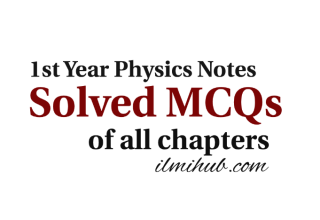In this post, I am sharing FSC 1st Year Physics Chapter 8 Short Questions with Answers Notes PDF for the students of intermediate part 1. This is chapter number 8 from the 11th physics textbook and its name is Waves. Students can download FSC 1st Year Physics Chapter 8 Short Questions Notes PDF on their laptop or mobile to read offline. These 11th Physics Chapter 8 Short Questions Notes are for all the boards working under Punjab Board like Gujranwala Board, Lahore Board, Faisalabad Board, Multan Board, Rawalpindi Board, Sargodha Board, DG Kahn Board, and Sahiwal Board. You can also download the complete FSC 1st Year Physics Notes PDF of all chapters from ilmihub.com.
11th Class Physics Chapter 8 Waves Short Questions Notes PDF Download
FSC Part 1 Physics Chapter 8 SQ Notes PDF Download
What features do longitudinal waves have in common with transverse waves?
The common features of longitudinal and transverse waves are
Both are mechanical waves
All waves transfer energy from one point to another point without transferring matter.
both produce disturbance in the medium through which they travel.
both waves obey the relation
Explain the term crest, trough, node, antinodes
Crest;
The portion of the transverse wave above the mean position is called the crest.
Trough;
The portion of the transverse wave below the mean position is called the trough.
Node;
The point of the stationary wave where the particle of medium vibrates with zero amplitude is called a node.
Anti node;
The point of the stationary wave where the particle of medium vibrates with maximum amplitude is called an anti-node.
How beats are useful in tuning musical instruments?
When an un-tuned musical instrument and the musical instrument if standard frequency are sounded together, beats are produced due to the difference of their frequencies. Therefore the frequency of un-tuned musical instruments is adjusted by losing or tightening the strings of musical instruments. Hence in this way, an un-tuned instrument is tuned.
How should a sound source move with respect to an observer so that the frequency of its sound does not change?
When the source and observer both move along the same direction at the same speed, then their relative velocity is zero and the apparent frequency of sound does not change. So, the doppler effect is zero.
Define mechanical and electromagnetic waves, Give an example of each.
The waves which require some medium for their propagation and which propagate through a medium due to the oscillations of particles of the medium are called mechanical waves
Example:
sound waves
water waves etc
Electromagnetic Waves
The waves which do not require any medium for their propagation and which propagate due to the oscillations of electric and magnetic fields are called electromagnetic waves.
Related Links:
- FSC 1st Year Physics Chapter 8 Chapter Notes PDF Download
- 1st Year Physics Chapter 8 Solved Numericals Notes PDF Download
- 11th Class Physics Chapter 8 Solved MCQs Notes PDF Download
- Class 11 Physics Solved Numbericals of All Chapters
- 11th Class Physics Solved MCQs of All Chapters
- 1st Year Physics Short Questions with Answers Chapter-wise





